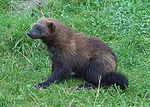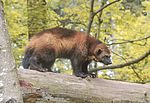Lates is a genus of freshwater and euryhaline lates perches belonging to the family Latidae. The generic name is also used as a common name, lates, for...
5 KB (453 words) - 20:32, 14 October 2023
The Tanganyika lates (Lates angustifrons)is a species of lates perch endemic to Lake Tanganyika. It is a widespread predator on other fishes. This species...
2 KB (159 words) - 09:24, 8 October 2022
castroaguirrei) Kribia leonensis Tanganyika lates (Lates angustifrons) Albert lates (Lates macrophthalmus) Forktail lates (Lates microlepis) White steenbras (Lithognathus...
49 KB (3,274 words) - 02:38, 11 June 2024
accepted extant species: S. gracilis, S. putorius, S. pygmaea, and S. angustifrons. New research, however, proposes that there may be up to seven.[better source needed]...
17 KB (1,746 words) - 21:02, 11 August 2024
Halichoeres socialis Scarus trispinosus Paraclinus magdalenae Lates angustifrons Lates macrophthalmus Lates microlepis Lopholatilus chamaeleonticeps Terateleotris...
169 KB (9,532 words) - 02:43, 18 August 2024
Paleorhinus (redirect from Paleorhinus angustifrons)
Chalk Quarry 3A. P. angustifrons was first described and named by Oskar Kuhn in 1936 as a species of Francosuchus. P. angustifrons is known exclusively...
22 KB (2,182 words) - 18:04, 11 October 2023
Parasuchus (category Late Triassic reptiles of Asia)
described in the late 1970s. Parasuchus hislopi and the two unambiguously valid species of Paleorhinus (P. bransoni and P. angustifrons) are all closely...
13 KB (1,190 words) - 02:50, 28 November 2023
forktail lates (Lates microlepis) and sleek lates (L. stappersii). Two additional lates are found in the lake, the Tanganyika lates (L. angustifrons) and...
54 KB (5,675 words) - 17:46, 22 September 2024
perceives pheromones. Female domestic cats can have kittens from spring to late autumn in temperate zones and throughout the year in equatorial regions,...
161 KB (16,544 words) - 20:50, 29 September 2024
Scalenodon (redirect from Scalenodon angustifrons)
only distantly related to S. angustifrons. S. hirschsoni was placed in its own genus, Mandagomphodon, in 2013. S. angustifrons and S. boreus remain valid...
4 KB (462 words) - 13:01, 29 June 2024
Ebrachosuchus (category Late Triassic reptiles of Europe)
and Lucas (1991) mistakenly referred to Francosuchus angustifrons as Ebrachosuchus angustifrons, and considered it and the other two Francosuchus species...
3 KB (281 words) - 14:21, 11 September 2023
extinct relatives are known dating back at least 7 million years to the Late Miocene. These include Mellivora benfieldi from South Africa and Italy, Promellivora...
29 KB (2,972 words) - 19:44, 21 September 2024
badger (M. marchei) Spilogale (spotted skunks) Southern spotted skunk (S. angustifrons) Western spotted skunk (S. gracilis) Eastern spotted skunk (S. putorius)...
6 KB (484 words) - 07:10, 27 September 2024
Dog (category Extant Late Pleistocene first appearances)
dog, it was domesticated from an extinct population of wolves during the Late Pleistocene, over 14,000 years ago by hunter-gatherers, prior to the development...
170 KB (16,023 words) - 20:03, 29 September 2024
with wolverines have been noted in Latvia, the most recent one being in late July 2022 (although it can be disputed because of the unclear footage); the...
61 KB (5,924 words) - 17:57, 23 September 2024
Species, as its range is thought to have declined by 53% to 68% since the late 1990s. Major threats to tigers are habitat destruction and fragmentation...
148 KB (16,394 words) - 01:32, 30 September 2024
Zhyrasuchus (redirect from Zhyrasuchus angustifrons)
described in 1989 by Lev Nesov and colleagues. The type species is Z. angustifrons. A 2000 review by Glenn Storrs and Mikhail Efimov could not determine...
2 KB (148 words) - 18:31, 13 June 2022
Fossil evidence suggests that this genus appeared in North America and later spread to Eurasia during the Pliocene. Diagnostic traits include a strongly...
2 KB (152 words) - 21:01, 11 August 2024
introduction of Nile perch (Lates niloticus) to Lake Victoria after 1954 severely upset the lake's ecosystem. By the late 1970s, the perch's population...
37 KB (2,454 words) - 23:30, 11 August 2024
roughly 60 to 70 days of gestation. Sometimes, a second litter is born as late as September. The female generally gives birth in an enclosed space, usually...
74 KB (8,183 words) - 16:35, 26 June 2024
long thin legs and a long tail. The cheetah was first described in the late 18th century. Four subspecies are recognised today that are native to Africa...
189 KB (19,497 words) - 18:26, 30 September 2024
that the evolutionary radiation of the Felidae began in Asia during the late Miocene around 14.45 to 8.38 million years ago. Analysis of mitochondrial...
58 KB (6,288 words) - 03:23, 18 September 2024
Infant Jesus of Prague. The stoat was introduced into New Zealand in the late 19th century to control rabbits, but had a devastating effect on native bird...
46 KB (4,884 words) - 17:00, 26 September 2024
Jupijkam is an extinct genus of phytosaur from the Late Triassic of Nova Scotia, Canada. The genus is monotypic, including only the species Jupijkam paleofluvialis...
10 KB (893 words) - 17:20, 15 January 2024
the Iberian Peninsula, Italy and France. Genet fossils from the Late Miocene and later have been found at sites in Ethiopia, Kenya and Morocco. Genetta...
34 KB (3,409 words) - 13:50, 21 July 2024
Phytosaur (category Late Triassic reptiles)
meaning 'plant lizard') are an extinct group of large, mostly semiaquatic Late Triassic archosauriform reptiles. Phytosaurs belong to the order Phytosauria...
40 KB (4,072 words) - 15:40, 29 August 2024
active at any time of the day. Activity is highest in June and decreases in late summer to autumn with an increase from November through the following March...
105 KB (10,941 words) - 07:53, 25 September 2024
Tjumen area: Mountain reindeer, Rangifer tarandus; Kemerovo area: R.t. angustifrons; Irkutsk area: Siberian forest reindeer R. t. valentinae, wild forest...
22 KB (2,527 words) - 10:46, 22 July 2024
are inedible, and leave them to ripen in a cache, coming back a few days later to consume the softened pulp. The tayra was found to be a host of an intestinal...
13 KB (1,466 words) - 09:31, 12 August 2024
spring. The kits are subsequently raised by their mother until dispersal in late fall. Although captive raccoons have been known to live over 20 years, their...
123 KB (13,448 words) - 19:52, 30 September 2024


























